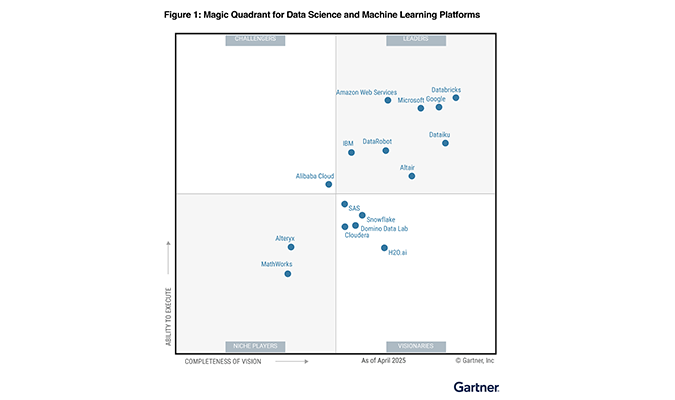
AI and Machine Learning
Altair's data analytics tools prove that using artificial intelligence (AI) and machine learning doesn't need to be difficult to be powerful. Our software is efficient and easy to use for business analysts and data scientists alike, enabling users at all skill levels to produce robust data analyses without needing to code. With Altair, users can connect unstructured and siloed data sources, modernize analytics applications while supporting legacy systems, and expedite team collaboration to produce meaningful, high-impact results quicker and easier than ever before.

Intuitive Machine Learning for All
Empower anyone within your organization—whether they’re a trained data scientist or an analytically minded domain expert—to create machine learning models through an automated, visual, or code-based approach. Altair empowers users of all skills levels, enabling them to work together on projects and establish a single source of truth for every model your teams create.

Modernize Your SAS Language Environment
Maintain and run your existing SAS language programs without needing to run any third-party products or licenses. Write data-centric applications using the best programming languages for the job, mixing syntax from different languages inside a single program. Choose cloud, on-premises, or hybrid infrastructure.

Generative AI with More Accurate Results
Altair® RapidMiner®’s generative AI tool puts access to hundreds of thousands of large language models (LLMs) at users’ fingertips. Our versatile and customizable extension offers a secure, cost-effective, and easy-to-use way to leverage generative AI’s capabilities.

Obtain Quicker Insights with AutoML
Build predictive models in just a few clicks. Leverage automated functionality including autoML, auto-forecasting, auto-feature engineering, and auto-clustering to build the best model for your use case. Open any model as a visual workflow for explainability, refinement, and tuning – no black boxes here.

Code-Like Control Without Complexity
Benefit from more than 1,500 algorithms and functions that support the latest machine learning techniques and replicate tasks that could previously only be performed with code. You'll never end up in a Python editor unless you choose to.

Integrated Coding Environment
Those that prefer to code in Python can develop code in the same platform as their non-coding colleagues, sharing data sources, assets, and using the deployment capabilities available.
Data scientists can leverage the power of Python and utilize its vast ecosystem of open-source libraries, prototype code in notebooks or use workspaces, and access a full-fledged integrated development environment to develop production-grade code with centrally governed Python environments.
Master complex concepts with ease with our Blueprint series, a comprehensive learning initiative that simplifies technical concepts into easy-to-follow modules.

Explainability Data Scientists Need
Increase trust with interactive decision trees and sharable model simulators. Calculate global feature weights to understand the factors driving a model’s predictions. Dig into local feature weights to examine which features are the most influential for a given model’s predictions. Explore partial dependencies to see how a model interacts with a single column in a data set.

Code-Free MLOps
Turn promising projects into impactful business solutions. With no-code deployment, automatic monitoring, and insight delivery capabilities, your team can easily put strong models into production, ensure they create long-term value, and make results easy to consume with custom dashboards, our data visualization solutions, or another business intelligence (BI) platform.

Pressure Test Your Models
Thoroughly validate models before making the case to deploy them. Accurately estimate model performance by preventing information used in pre-processing steps from leaking into your model's application. Control model overfitting by using tried and true model assessment techniques like cross and split validation.
Want to see our market-leading machine learning tools in action?
Book a DemoFeatured Resources

Make Machine Learning Work for You
Protecting consumers and enterprises involved in online transactions is just one example of how machine learning (ML) influences our daily lives. In fact, the list of use cases is already long, diverse and growing fast. The reason is clear – ML is a game-changing tool that enables organizations to make better decisions faster. What's more, ML is highly effective at balancing conflicting objectives.
Given the breadth and depth of potential use cases, one thing is clear – more and more people will find themselves working in environments where ML plays a critical role. And thanks to the emergence of low-code and no-code software, ML is no longer the exclusive preserve of programmers, data scientists, and people who paid attention in math class. More of us can, and will, be involved in developing and deploying practical ML solutions.
This eGuide will help you understand the key concepts behind ML, some common applications, and how ML becoming more useful to people at all levels of the modern organization.

Accelerate Your Data-Driven Transformation
If you’re a leader who’s thinking about what digital transformation means for your organization, you may be wondering if data science lives up to the hype. You know that advanced analytics, machine learning, and AI projects have promise, but what’s their actual impact on business results?
This commissioned study conducted by Forrester Consulting on behalf of Altair RapidMiner polls leading digital transformation executives to understand the ROI, challenges, and benefits of starting data science programs so you can better understand what your peers are thinking about and investing in to try and gain a competitive edge.

Machine Learning in Engineering
When applied to engineering, Machine Learning can be a powerful tool to aid in a range of applications, from faster finite-element (FE) model building to optimizing manufacturing processes and obtaining more accurate results from physics-based simulations. Although incorporating this collection of technology is relatively new in the field of engineering, Altair has made leaps forward in this space to provide users with the tools they need to make a difference.

Game-Changing Financial Analytics
Credit risk specialist builds robust SAS language-powered analytics framework. Vestigo uses Altair Analytics Workbench to develop and maintain models and programs written in the SAS language. The software's drag-and-drop workflow lets its teams build new models quickly without needing to write any code. When the team needs to update existing client libraries, they can work with clients regardless of what language the client used to build them originally since Analytics Workbench can handle Python, R, and SQL in addition to the SAS language. The Vestigo team can combine modules built in any of the four languages into their updated models.



